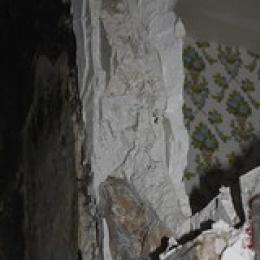I am cleaning old tiles, tomette, terracotta, cement tiles, glazed tiles, different seizes, tiles we found inbuilt in walls, on the floors we have to renew or simply on walls. All together, I already cleaned about 50 sqm.
It’s not an intellectual challenge, its physical. I feel every muscle in my arms, from my hands to my shoulders, it’s even hard to write on a keyboard after hours of cleaning.
house restoration
We thought we emptied all, but during the last weeks we took more plaster of the walls, removed some layers from a floor and thus, generated another 2,5 tonnes to bring to the dumping ground. Amongst some very old asbestos tubes, which to dispose was quite expensive.
So, the house is empty now.
All the stuff which was inside we brought to the waste disposal sites, all the little walls are removed and now, we can see clearly damages on the beams, roof and the outer walls, can make plan how to continue.
We removed a lot of interior walls, which, according to some village people who know the house since a very long time, were made in the nineteen sixties.
We found it totally fascinating that these walls were made with cut stones from the Garrigue or partly with terra cotta tiles, put in a lot of gypsum. They were very thin, but heavy.
Anyway, we broke down all of them and reuse the stones in our garden. The tiles we have to clean and then we’ll reuse them in the house 😉
During the last four weeks, we emptied the house as it was full with a lot of stuff: old, rotten furniture, rubbish, bottles and other undefinable things. Usable items we gave to Emmaus, all the rest we brought to our nearby dècheteries.
Along with this, we also broke down all the internal walls (there were up to 6 rooms on one level!), removed the gypsum paneling on the beams, dismantled installations, ovens, tapestry and floor coverings. All in all, we filled one big container with old stuff and about 60 trailers à 600 kg with plaster, gypsum, bricks, wood and dirt.
This house in Fitou, France, probably dates back to the late 17th or beginning of 18th century and has been built in the shape how it appears nowadays.
It is, as many other houses of that decade, built with stones from the Garrigue and plastered with lime mortar. The house lies between two streets, the main street of the village and a smaller street, mainly used by pedestrians. Therefore, it has two entries, on in the back for people only and one at the front, for the trailers and tractors, because as so many people in the village, the owners were farmers e.g. winemakers.
The “About houses” project started two years ago and comes to an end right now.
A lot of stuff, in seven languages, has been done:







